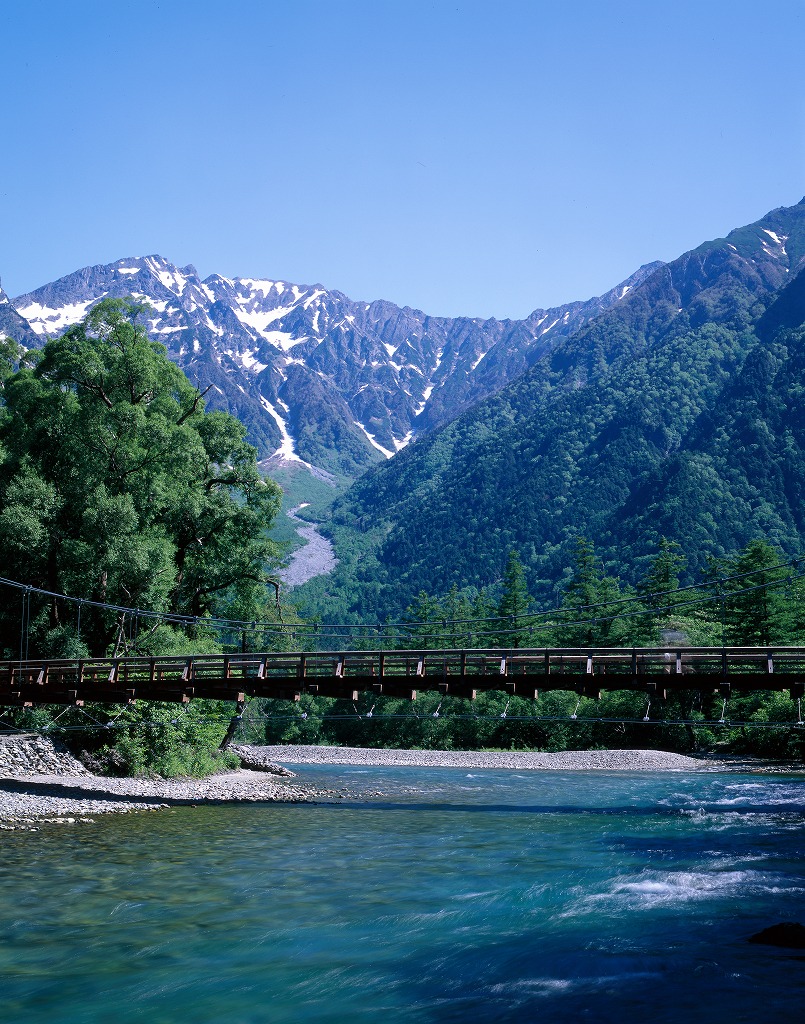実施日 : 2016年06月09日(木) - 10日(金)
Notice: Nagano Press Tour
投稿日 : 2016年05月19日
Mountain Day, a Unique New Holiday, and the Scenic Beauty of Kamikochi
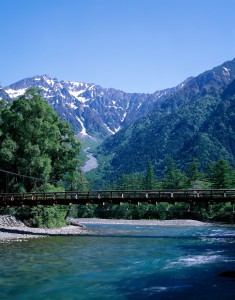
Starting this year, Mountain Day (August 11) is a new Japanese national holiday. With over 70% of Japan’s land mass covered in mountainous terrain, from ancient times Japanese people have lived with and respected mountains. This holiday has been introduced to “provide an opportunity to enjoy mountains and to be grateful for the blessings that mountains provide.” This is the first national holiday in the world to be based around mountains. The inaugural national ceremony for Mountain Day will be held in Kamikochi, Matsumoto, in western Nagano prefecture. The area is popular with mountain climbers as the gateway to the Japanese Northern Alps. English missionary Walter Weston first visited Japan in the late 1800s, and after climbing in the Northern Alps he published Mountaineering and Exploration in the Japanese Alps. He is credited with having introducing the Japanese public to the concept of mountaineering as a sport, as until then mountains had been primarily treated as objects of worship or sources of lumber. In Nagano prefecture’s case, 79% of the prefecture is covered in forest, and of the 23 peaks in Japan with a height of over 3,000 meters, 15 are in Nagano prefecture and 9 are in Matsumoto.
In recent years, there has been a continued boom in mountain climbing, particularly among youth, and in 2014 it was estimated that 8.4 million people in Japan had gone mountain climbing. While the increased number of people in the mountains has caused issues such as increased damage to the environment and more people requiring rescue, local residents and businesses in Kamikochi and Matsumoto have implemented various initiatives to protect the environment and allow people to enjoy mountain climbing safely.
Nagano Life Expectancy, Among the Highest in the World
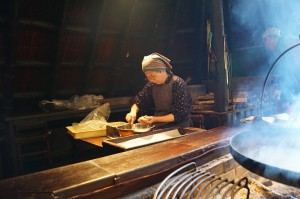
The average life expectancy in Nagano prefecture is 80.88 years for males, and 87.18 years for females (as of 2010), both of which are the highest in Japan. Reasons for this include years of hard effort by residents, promoting checkups and improved diets. The prefectural government is working towards creating a healthy longevity society where people can live active lives. In addition to an initiative to promote balanced diets with reduced salt, there is a business that has developed a system that analyzes how people walk, with the goal of encouraging healthy methods of walking and ensuring no one is bedridden. There is also a local food manufacturer that is symbolic of Nagano prefecture, where over one third of the employees are 65 or older.
The National Ceremony for Mountain Day will be held in Kamikochi in August, and the G7 Transport Ministers’ Meeting will be held in Karuizawa in September. This press tour will cover the appeal of Kamikochi, one of Japan’s most popular mountain resorts, as well as initiatives for environmental protection, safe mountain climbing, and becoming the healthiest, longest-lived place in the world.
*This press tour is sponsored by the G7 Transport Ministers' Meeting Nagano Promotion Council and the Organizing Committee for the Inaugural National Ceremony for Mountain Day, with planning cooperation by the FPCJ.
*This press tour will require participants to bear part of the cost, but is not a profit-making venture.
[Tour Details]
1. Nagano Life Expectancy, Among the Highest in the World (Day 1)
(1) Longevity Based on Group Checkups and Preventive Education
Saku Central Hospital, Honorary Director Shusuke Natsukawa
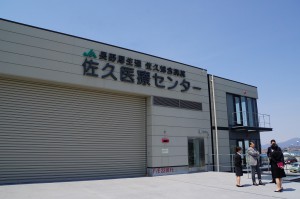 One of the reasons for Nagano prefecture having some of the highest life expectancies in the world is due to healthcare that deals closely with the local community. By teaching the importance of preventing disease through regular checkups, each resident has a greater awareness of their health. Saku Central Hospital, located in Saku in eastern Nagano, played a central role in this process. Shortly after World War II, based on the principle that “prevention is better than treatment,” the doctors and nurses went out to farming villages to perform checkups and treatment on site. This movement spread throughout Japan, and people grew to believe “protecting my health is my own responsibility,” helping to form the basis for group checkups held at companies or in local communities. Saku Central Hospital carries out approximately 300 group checkups around Nagano prefecture in a year, giving checkups to approximately 80,000 people.
One of the reasons for Nagano prefecture having some of the highest life expectancies in the world is due to healthcare that deals closely with the local community. By teaching the importance of preventing disease through regular checkups, each resident has a greater awareness of their health. Saku Central Hospital, located in Saku in eastern Nagano, played a central role in this process. Shortly after World War II, based on the principle that “prevention is better than treatment,” the doctors and nurses went out to farming villages to perform checkups and treatment on site. This movement spread throughout Japan, and people grew to believe “protecting my health is my own responsibility,” helping to form the basis for group checkups held at companies or in local communities. Saku Central Hospital carries out approximately 300 group checkups around Nagano prefecture in a year, giving checkups to approximately 80,000 people.
Saku Central Hospital Honorary Director Shusuke Natsukawa will speak about the reasons behind the longevity of Nagano residents, the history of group checkups started by this hospital, and current initiatives. The tour will also have an opportunity to see the hospital’s rehabilitation center.
(2) Promoting Healthy Diets Locally: Pinkoro Meals and Pinkoro Jizo
Saku City Diet Improvement Promotion Council, Representative Yayoi Tsuchiya

Residents of Nagano prefecture consume an average of 370 grams of vegetables per day. At approximately 80 grams above the national average, Nagano is No. 1 in Japan. On the other hand, due to factors such as pickles featuring heavily in Nagano’s traditional diet, excessive salt consumption has long been an issue for the prefecture, and it is still the second worst in Japan for this statistic. “Diet improvement promoters”, called shokkai-san in Nagano, work to spread healthy eating habits throughout the prefecture. After finishing training programs held by local governments, diet improvement promoters register with their local Diet Improvement Promotion Council, and carry out local activities to promote the adoption of healthy diets. Some activities include teaching lessons at elementary schools, or holding cooking classes for different target audiences such as parents or seniors. The council’s activities are funded by membership fees and commissions from local governments. Currently, there are approximately 150,000 diet improvement promoters throughout Japan, with about 3,500 in Nagano prefecture. This is twice the number of promoters as are registered in Tochigi prefecture, which has a population close to Nagano prefecture (two million). Diet improvement promoters have been trying to reduce salt consumption for the past 40 years, and as a result of efforts such as promoting vegetable dishes other than pickles and visiting homes to test salt levels in miso soup, the death rate from strokes, which excessive salt consumption is considered a primary contributor to, decreased from worst in Japan (in the 1960s) to 13th-worst for men and 7th-worst for women (as of 2000).
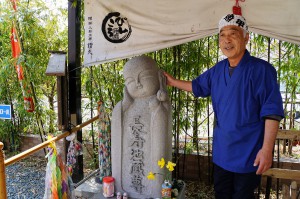
The 160 diet improvement promoters in Saku City hold monthly meetings in each district, where they cook recipes made by dieticians and provide feedback on how practical they are to make, to study hands-on how to make meals with reasonable levels of salt. By using the recipes learned at these meetings in their own homes and teaching them to others in their communities, healthy eating habits are spread.
The diet improvement promoters of Saku City are working on even greater adoption of “pinkoro meals,” which are proposed by the city and are even available at some restaurants. “Pinkoro” refers to living a long, healthy life before passing away peacefully. Pinkoro meals have three standards: each meal has to be between 600 and 700 kcal; each meal’s salt content must be 3–4 grams or less; and it must use local ingredients. Saku is also known for the Pinkoro Jizo statue, which is a popular spot that 100,000 to 150,000 tourists come to visit every year and pray for longevity. The city is working to become a city of health and long life, with pinkoro as the keyword.
-The tour will visit the Saku City Civic Soren Center, where diet improvement promoters will hold a meeting, cooking a pinkoro meal and performing the exercises they always do before cooking.
-The tour will be guided to the Pinkoro Jizo statue by Akito Ichikawa, director of the Nozawa Merchant’s Association, who often shows tourists the statue.
(3) Local Specialty Food Manufacturer with a 92 Year Old Employee
Ogawanosho, CEO Koryu Gonda

Nagano prefecture has the highest rate of employment in Japan for people 65 and over, at 38.5% for men and 19.7% for women. In the case of men, this is nearly 10% above the national average. Many of them are agricultural workers, but there are also other businesses with active seniors. One of Ogawanosho’s main products is oyaki, a local specialty in which fillings such as nozawana [turnip greens] pickles or seasonal vegetables are wrapped in flour dough and steamed or toasted. Of the company’s 83 employees, 30 are 65 or older, but there is no set retirement age and they can work as long as they want to. The company has three locations in Nagano, and at the Oyaki Village location in Ogawa, there is a restaurant along with the oyaki production facilities. The company’s oldest employee, 92-year-old Chikayoshi Gonda, cooks the oyaki at the traditional hearth [irori] there. Saying “If I don’t work every day, my body will break down,” Mr. Gonda works full-time, six days a week. Ogawanosho CEO Koryu Gonda spoke about his goals: “Some areas have populations with over 40% seniors, but I would like to maintain places they can walk to themselves and work, in order to help stimulate those areas. I would also like to see oyaki spread throughout Japan.”
The tour will visit Oyaki Village, and hear about Ogawanosho’s work style and business conditions. There will be an opportunity to see where the oyaki is made, to make and eat oyaki, and to take photographs and film around the traditional irori hearth. It will also be possible to speak with senior employees, such as Mr. Chikayoshi Gonda.
(4) Working to Ensure No One Becomes Bedridden: Analyzing How People Walk to Help Live Healthy, Long Lives
MicroStone, CEO Norihiko Shiratori
“Even though we do health checkups, there are no opportunities to check how we walk, which is vital to maintaining health.” MicroStone CEO Norihiko Shiratori has manufactured and sold sensors that prevent accidents by monitoring the movements of industrial robots and productions lines for automobile and home electronics makers. Using this technology, last year the company developed THE WALKING®, a product which uses sensors to monitor how people walk. By walking approximately 10 meters while wearing belts around the hips and back with sensors small enough to fit in the palm of your hand, data on the body’s up-and-down, side-to-side, and back-and-forth movement is wirelessly sent to a computer, making it possible to understand how the body is being used while walking. At their Kyukaruizawa location that opened in April this year, the walking data is used by a health fitness programmer with basic knowledge of medicine and kinesiology to provide advice on how to walk in a manner that will cause the body less stress, and to teach exercises to help improve how the body is used when walking. It is possible to display two sets of walking data at the same time on their monitors, so that walking before and after the session can be compared. Around 30 software and sensor sets (approx. 500,000 yen each) have already been sold in Japan, both to hospitals with rehabilitation facilities as well as to other businesses such as research facilities of underwear and shoes manufacturers. The company aims to sell 10 or so sets per month, hoping to make them regularly available throughout Japan by the 2020 Tokyo Olympics and Paralympics. In addition to increasing sales, the company has begun preparations to train physiotherapists and health fitness programmers who can analyze the data collected and instruct people on better ways to walk. Mr. Shiratori described his goals: “Just like household blood-pressure monitors have become common, I would like to see ‘THE WALKING®’ be widely adopted to increase the number of people who can walk their whole lives.” He is also looking into expanding overseas, and having already completed a deal in Dubai, he is aiming to expand to Indonesia and Europe next.
The tour will visit MicroStone, where they will hear about how THE WALKING® works, and future plans for the company. Next, walking data will be measured and analyzed to provide instruction and exercises based on the results. Measurements will be carried out again at the end to see how the results differ.
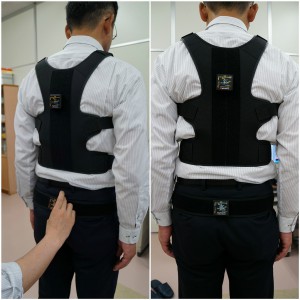
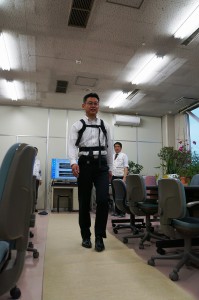
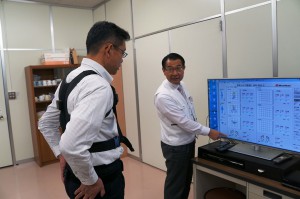
2. Mountain Day, a Unique New Holiday, and the Scenic Beauty of Kamikochi (Day 2)
(1) Kamikochi, Venue for the Mountain Day National Ceremony
Mountain Day National Ceremony Promotion Office, Manager Ginjiro Kato (Matsumoto City Commerce, Industry, and Tourism Section Chief)
Toshiaki Kamijo, Kamikochi Town Council Chairman

The venue for the Mountain Day National Ceremony, Kamikochi is a valley 1,500 meters above sea level located in the Japanese Northern Alps, with the Azusa River flowing through its center. Until being designated as Chubu-Sangaku National Park in 1934, there were ranches in the area, and the forestry industry was also active. The Kamikochi Imperial Hotel opened around the time of the national park designation, and quickly became popular with its beautiful views of the Hotaka Mountains. Now it is one of Japan’s most popular mountain resorts, with 1.2-1.3 million visiting yearly from Japan and abroad to enjoy hiking and other activities. Although this increase in tourists also leads to problems with pollution, Kamikochi quickly implemented initiatives led by local residents that were successful in ensuring harmony between tourism and the environment. The “Make Kamikochi Beautiful” group established by residents in 1963 worked on protecting the environment through campaigns to discourage smoking while walking and to pick up litter while hiking, and still carry out cleaning activities weekly. In 1975, the local city, Matsumoto, was also the first city in Japan to put regulations on private car use. With private cars no longer allowed to enter Kamikochi year-round, the problems of the area overflowing with cars and exhaust were solved. There are also strict regulations in place where during certain days (25 days this year) not even tour buses are allowed to enter Kamikochi. With these measures, the clean air, beautiful river, plants, and animals of Kamikochi are protected, and this abundant nature has recently been attracting overseas tourists as well, particularly from the rest of Asia.
Mr. Ginjiro Kato of the Mountain Day National Ceremony Promotion Office will speak about the reason behind establishing Mountain Day. Next, Director Satomi Ishizuka of the authorized NPO Yamatami Mountain Guide Association will guide the tour around Kamikochi for approximately two hours of walking, allowing for photographs and filming. Kamikochi Town Council Chairman Toshiaki Kamijo will then give an explanation on local efforts to both protect the environment and encourage tourism.
(2) Community Site for Safer and More Fun Mountain Climbing
Yamareco Inc., CEO Kazumine Matoba (39)
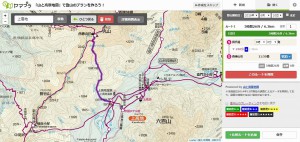
Yamareco is a mountain-climbing community site established in 2005 by CEO Kazumine Matoba, who learned programming during his spare time while working at a research laboratory for a major IT firm. The site has a variety of information on mountain climbing, with the ability to display hiking routes and actual pictures from routes along maps, and information about mountain climbing equipment and events. The site receives over 1.5 million visitors monthly, and data from around 4,000 climbs is added each week, reaching a total of 770,000 climb records at the beginning of May 2016.
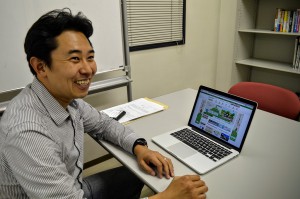 Yamareco not only has information to enjoy mountain climbing, it also provides services to make mountain climbing safer. After the large number of casualties from the 2014 eruption of Mount Ontake, and the approximately 2,300 cases nationwide of hikers requiring rescue (the highest since recording statistics began), Nagano Prefecture introduced a Mountain Climbing Safety Ordinance that will take effect July this year. The ordinance requires everyone who plans to take mountain climbing routes considered to be risky to submit a Mountain Climbing Plan that includes the planned route, emergency contact information, and evacuation routes. The new service provided by Yamareco, Yamapla, allows users to easily make a Mountain Climbing Plan on the website, send it by email, and submit it to the proper authorities such as police departments.
Yamareco not only has information to enjoy mountain climbing, it also provides services to make mountain climbing safer. After the large number of casualties from the 2014 eruption of Mount Ontake, and the approximately 2,300 cases nationwide of hikers requiring rescue (the highest since recording statistics began), Nagano Prefecture introduced a Mountain Climbing Safety Ordinance that will take effect July this year. The ordinance requires everyone who plans to take mountain climbing routes considered to be risky to submit a Mountain Climbing Plan that includes the planned route, emergency contact information, and evacuation routes. The new service provided by Yamareco, Yamapla, allows users to easily make a Mountain Climbing Plan on the website, send it by email, and submit it to the proper authorities such as police departments.
Yamareco is also planning to participate in Nagano Prefecture’s mountain distress prevention model project, to coincide with the implementation of the Mountain Climbing Safety Ordinance. This system will enable hikers to inform their family of their current location by swiping an IC card on a receiver located in mountain lodges, providing useful information to find the hiker when compared with their mountain climbing plan should they end up in distress. This is an extension of a service Yamareco already provides with mobile phones.
Yamereco’s CEO Mr. Matoba will give an explanation about the mountain-climbing community site, along with a demonstration of features such as registering records of a mountain climb. He will also describe projects the company is involved in to ensure safety when mountain climbing.
[Tour Itinerary]
1. Dates: Thursday, June 9 to Friday, June 10, 2016
[Day 1]
|
7:24-8:52 |
Hokuriku Shinkansen Asama 603: Tokyo Station→Sakudaira Station |
|
9:15-10:10 |
MicroStone |
|
10:30-11:25 |
Saku Central Hospital (Saku Central Hospital Advanced Care Center) |
|
11:45-12:50 |
Diet improvement promotion activities (pinkoro meals, etc.) |
|
13:10-13:35 |
Pinkoro Jizo |
|
15:00-16:00 |
Ogawanosho |
|
around 19:15 |
Stay in Kamikochi |
[Day 2]
|
8:00-11:50 |
Kamikochi tour (including briefing on Mountain Day and Kamikochi) |
|
11:50-12:35 |
Lunch reception |
|
12:35-14:05 |
Leave Kamikochi Bus Terminal→Central Matsumoto City |
|
14:05-14:45 |
Yamareco Inc. |
|
15:47-18:36 |
Limited Express Azusa 26: Matsumoto→Shinjuku |
*The schedule may be changed due to weather or other unforeseen circumstances.
2. Qualification: Bearer of Gaimusho Press Registration Card
3. Cost: 12,000 yen per person including transportation, accommodation and meal.
* FPCJ will later inform the participants of methods for payment, cancellation fee, etc.
4. Participants: Limited to 10 applicants.
(Only one reporter and one photographer from each company, but two participants from each TV team will be acceptable.)
*If the number of applicants exceeds 10, an upper limit may be set on the number of participants from each country.
5. FPCJ Contact: Ms. Yokota (Tel: 03-3501-3405)
6. Remarks:
(1) There may be some restrictions on photographing and filming at the tour sites. Please follow the instructions of the officials on duty.
(2) G7 Transport Ministers' Meeting Nagano Promotion Council , Matsumoto City and FPCJ will not be liable for any inconvenience, trouble or accidents that might occur during the tour.

